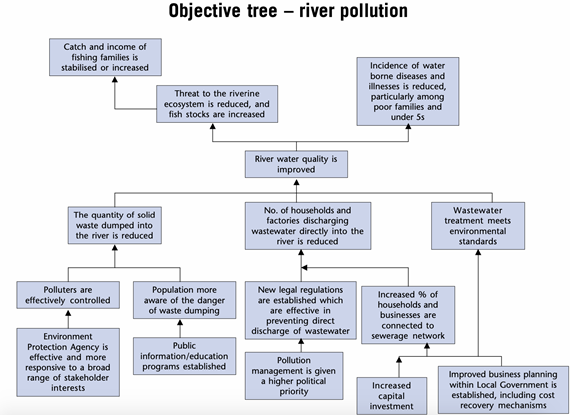The problem tree is a graphic tool helping to structure hierarchically problems identified (the negative situation), clarifying their cause effect relationship. The objective tree is the positive interface of the problem tree, hierarchically organizing the corresponding objectives (positive situation).
By synthesizing the present negative situation and the positive future situation, the problem / objective trees inform the problem analysis. It support specifically organisational decision making in identifying potential interventions and strategies.
The problems and objective trees are critical in the design (identification and formulation) phase. They are often used as a starting point to develop the intervention logic in the Logical Framework Approach.
The Problem tree: a summary of the existing negative situation
When developing a problem tree, the process can be as important as the product, offering the opportunity to brainstorm and categorise problems. Recommended steps are:
Further comments/information
Example of a Problem Tree |
 Source: European Commission, 2004. Aid Delivery Methods. Volume 1. Project Cycle Management Guidelines. Page 68. |
The 'negative situations' of the problem tree are converted in 'positive achievements'. These positive achievements are in fact objectives, and are presented in a diagram of objectives showing a means/ends hierarchy. In this sense, the indicative means by which ends can be achieved should be included.
If necessary:

Source: European Commission, 2004. Aid Delivery Methods. Volume 1. Project Cycle Management Guidelines. Page 70.
Data/information. Preliminary knowledge on the context is a key asset, as context analysis provides the strategic boundaries for the identification and assessment of problems. Response strategies are benchmarked through the analysis of lessons learned of interventions that used similar techniques, technologies, methodologies and approaches in relevant contexts.
Time. With the support of a specialist with a deep understanding of the context, and a facilitator helping to organise qualitative data collection, it can provide relevant information in a short time. The actual timing will depend on effective accessibility and participation of stakeholders.
Skills. The literature review can be performed in house, but specific competencies such as facilitation skills or technical expertise may be required to explore and assess problems identified in more depth. Local expertise can bring added value based on knowledge of local contexts.
Facilities and materials. Depend on data collection method(s) selected.
Financial costs and sources. If external expertise is required, funds should be made available to cover the costs associated with fees, travel expenses and logistics. These funds may come from the project itself or through other EC instruments such as a framework contract or a technical cooperation facility.
Tips and tricks
Ensure that all stakeholders have the same understanding of the problems, and consider their diversity when addressing objectives and potential solutions. In this perspective, the stakeholder analysis can provide you with key information.
For further information, any revision or comment, please contact INTPA-ICM-GUIDE@ec.europa.eu
Published by INTPA.D.4 - Quality and results, evaluation, knowledge management. Last update May 2025